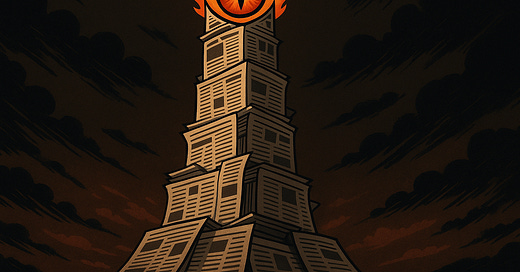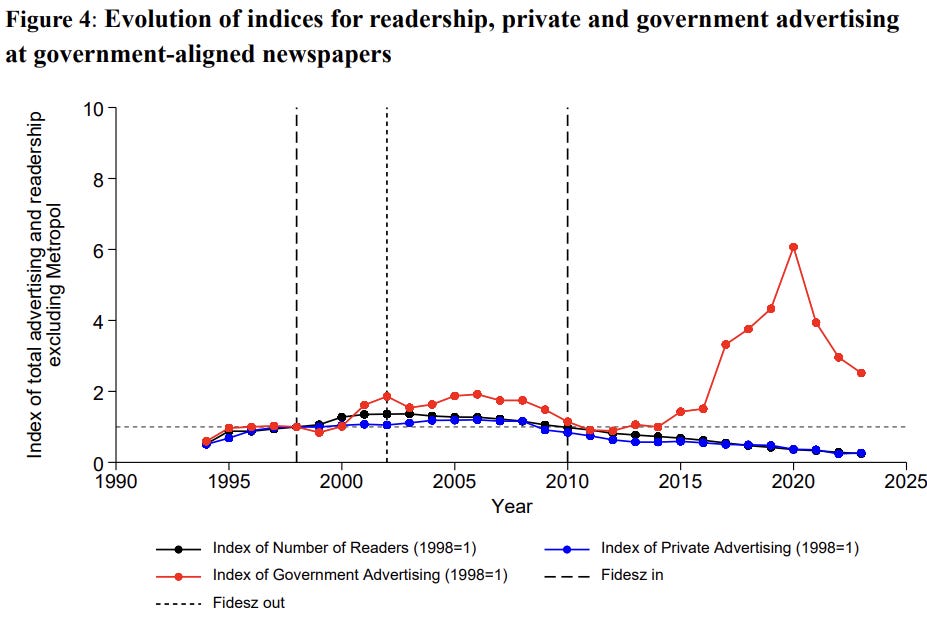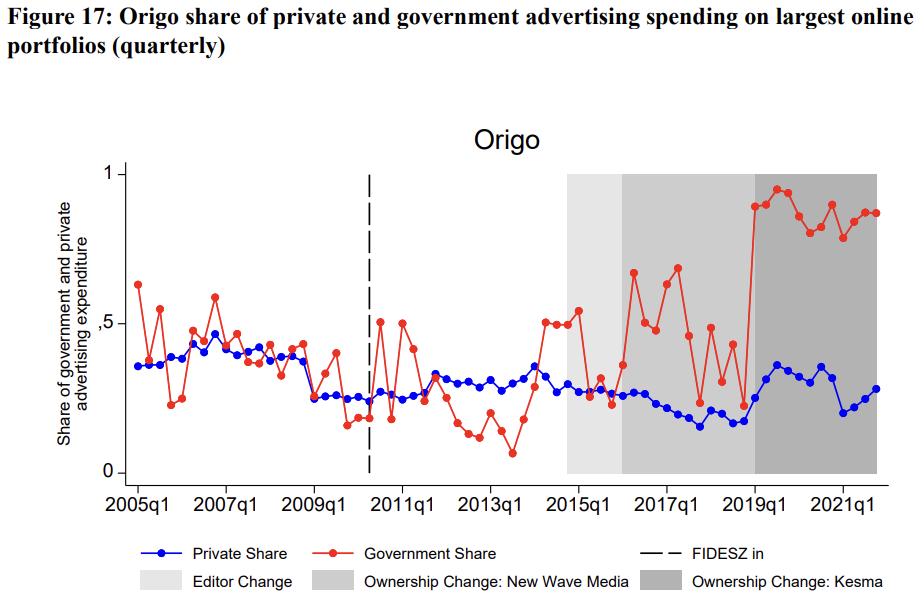Media funding, weaponized
Case studies from successful newsrooms, growing Facebook referral traffic, funding results and 21 active calls.
Welcome!
This week on the Media Finance Monitor:
Media funding, weaponized
This is how you build a viable newsrooms
24,366 subscriber in two weeks
Facebook referral traffic is growing for some publishers
Results from some important funding opportunities
21 active calls (5 new)
Media funding, weaponized
If you're a regular reader of this newsletter, you're probably aware that Budapest isn't currently the press freedom capital of the EU. Over the past decade, I've become increasingly convinced that press freedom isn't binary but rather exists on a complex spectrum. Media outlets navigate challenging environments and sometimes must compromise with powerful interests. Hungary has perhaps the most hostile media environment for independent journalism in the EU, but it's still light years better than places like Turkey, Russia, and various other repressive regimes.
The specific ways the Hungarian government interferes with independent journalism quite literally shaped my career. Contrary to popular belief, I didn't get into media finance because I was bitten by a radioactive funder during a high-school trip to a laboratory, but because the state interfered with the advertising market so extensively that our newsroom (444.hu at the time) desperately needed to find revenue elsewhere and I became one of the people who took on this challenge.
I testified about this in detail before the European Parliament's Justice Committee, but here's the short version: in Hungary and many other post-Communist countries, the state remains among the largest advertisers (through central government, municipalities, state-owned companies, etc.). They consistently advertise with outlets that toe the government line while starving even remotely independent-minded newsrooms. Beyond this, many large private advertisers, telecom companies, financial service providers, businesses in heavily regulated sectors that rely on government permits and licenses, are extremely cautious about where they spend their money, not wanting to upset those in power.
This dynamic, compounded by big tech disruption and other factors, creates very difficult conditions for independent newsrooms. Many economically weakened publishers are eventually taken over by government-aligned business figures, leading to alarming levels of media capture.
This method of interference isn't unique to Hungary, but the government here has pioneered the weaponization of ad spending and deployed it with disturbing effectiveness over the past 15 years.
Whether such interference is legal in an EU country has been the subject of both political and legal debates, but I'd argue there's now significant new evidence to consider.
Earlier this week, two Hungarian publishers lodged "a State aid complaint with the European Commission, challenging the Hungarian Government's advertising practices in the Hungarian media markets." They're arguing that the government's advertising expenditure (more than 1 billion euros since 2015) amounts to illegal state aid to certain publishers and distorts the fair market and competition. It's a compelling argument particularly well-suited for the EU context. While EU institutions may not always be eager to pick political battles with member states, they do care about fair competition, and to me, the Hungarian government's practices are clearly disruptive to that principle.
The complaint comes with a remarkably detailed study by Kai-Uwe Kühn, former Chief Economist at the European Commission's Competition Directorate. It doesn't just theoretically explain government interference in the advertising market, it demonstrates it in tangible, data-driven terms.
One chart shows the declining readership and private advertising spending for government-aligned newspapers, alongside government advertising (in red) in these same titles:
Notice how private advertising mostly follows market trends, while government advertising clearly doesn't.
Or consider this chart showing the changing fortunes of Origo, once a bastion of independence but now home to some of the most vicious government propaganda. Care to guess which approach proved more financially lucrative??
The study contains dozens more data visualizations like these, methodically demonstrating, outlet by outlet, year by year, how interference operates. Its relevance extends well beyond Hungary; a leading media executive from the Western Balkans recently described nearly identical dynamics in his country.
This is precisely what makes this case so consequential. On one hand, this method of interference is deployed globally, and if the European Commission determines it constitutes illegal state aid, it could effectively challenge similar practices throughout the EU and potentially beyond. On the other hand, if authorities (and subsequently the courts) find it legal, it provides an interference blueprint for similar regimes.
A previous complaint stalled for years at the EC, rumoredly because the Commission feared setting a bad precedent. While that concern is valid,I think the evidence compiled in this new case is overwhelming. In Europe, we should trust our institutions to make rules-based decisions in citizens' interests, at least for the short time while we still have them.
This is how you build a viable newsrooms
I'm going to sound like a fortune cookie, but I think what prevents many newsrooms from finding sustainable operating models is, at least in part, a lack of self-confidence. Consider this a preview of the caliber of management consultancy we offer to our clients. Feel free to reach out.
But seriously.
I've lost count of how many times excellent reporters, editors, and managers have told me it's "just impossible" to develop a new editorial product, engage a specific audience segment, or generate additional revenue from previously untapped sources. Not because of any insurmountable barrier, but because they fundamentally didn't believe enough in their own abilities or their communities.
This mindset is, of course, understandable. Much of journalism has been in perpetual crisis for over a decade. Newsrooms are shrinking, there's always some new format or platform to chase, competition keeps intensifying, and revenues remain elusive. Hardly an environment that inspires confidence. So even when people hear about successful new projects, many dismiss them outright: Not in our country. Not for our newsroom. Not with this audience.
This is precisely why I value case studies from smaller, younger outlets and newsrooms operating outside the Global North. It might be easy for a CEE newsroom to dismiss innovation coming from Denmark, but when you hear about small operations in Tunisia, India, or South Africa finding creative ways to serve their audiences and generate commercial revenue, you really have to consider that change might actually be possible for your organization too.
That's why I'm particularly excited about the new Entrepreneurial Journalism Playbook from IMS. It examines the operations and business models of four diverse media organizations:
The Better India, which sells eco-friendly home-cleaning products
Al Khatt from Tunisia, which offers technical tools and services for customers
Food For Mzansi from South Africa, which runs industry events and educational programs
Deník Alarm, which publishes books
Beyond these case studies, the Playbook explains fundamental concepts around business development, external financing, and related topics. I consider it essential reading for anyone starting a media business or curious about what innovation is on the business side outside the Global North. Food For Mzansi especially stands out as an excellent example of what a successful media company looks like in 2025.
24,366 subscriber in two weeks
(Another case study, from Slovakia, official audience revenue wonderland of CEE, but I promise you it’s great.)
We briefly covered Denník N's 10-year anniversary campaign previously, but their tech subsidiary, FatChili, has now created a detailed writeup of how the campaign worked, complete with fresh figures on retention.
On their 10th birthday, Denník N made 10 promises to their audience, from unlocking their entire archive to giving free subscriptions to all future first-time voters if they managed to generate 10,000 new subscriptions in 5 weeks. They reached this ambitious goal in just four days. And then kept going.
New readers could determine how much they wanted to pay for the 10-week trial. The default was €4, but they could also choose €0 (interestingly, only 22% opted to pay nothing). What's truly remarkable, though, is that Denník managed to retain a whopping 72% of these subscribers after the trial period ended.
During the campaign, the newsroom provided existing subscribers with tools to track how many new readers they personally recruited. They enlisted the help of creators and deployed marketing automation software to send personalized DMs to prospective subscribers. But I'm not doing the piece justice, you should really read the original by my friend Dávid Tvrdoň. It's worth your time.
Facebook referral traffic is growing for some publishers
Digiday has an interesting piece about the uptick in referral traffic from Facebook for some US publishers. This isn't entirely shocking after Mark Zuckerberg mentioned the potential return of newsy content back in January, but it still feels somewhat strange after years of steady decline.
As with many industry developments, I think you need to be pragmatic here (consider this your second fortune cookie of the day). Facebook remains an unreliable partner, and no one in the news media sector should build their business model around them. However, if you're seeing a traffic increase, that's great, and if it sustains for a meaningful period, you should absolutely explore easy ways to capitalize on it.
This situation parallels what's been happening with Google Discover. The principle remains the same: don't "pivot to video" or anything else simply because some platform company suddenly prioritizes it, but do take advantage of growth. If there are reasonable ways to catalyze this traffic without becoming dependent on it, go for it.
Just remember, platform priorities can and will change as quickly as they appeared, without warning or consultation.
Results from some important funding opportunities
As regular readers know, I think you should always follow who gets funding. Usually there is a ton to learn from others, especially from newsrooms that successfully secured grants, and in my experience, people tend to be surprisingly open to sharing information with peers, if you reach out to them directly (and respectfully). So with this in mind, here are some recent results from
Also, in related news, OCCRP made it into the final round of $100 Million Competition.
Here are the active calls, with the largest at the top:
Pan-European reporting - NEW
Who: European Commission
How much: Up to EUR 7,500,000
What is it for: Support pan-European, multilingual reporting on EU affairs
How long: Between 12 and 24 months (depending on the topic)
Deadline: June 13th, 2025
Eligible countries: EU Member States (including overseas countries and territories)
Support for Civil Society Organisations in the Republic of Moldova in 2025
Who: European Commission
How much: Up to EUR 2,500,000 (Lot 2)
What is it for: Building civil society capacity for EU integration engagement (counter hate speech, disinformation, and harassment online)
How long: Between 28 to 42 months
Deadline: May 5th, 2025
Eligible countries: Republic of Moldova
CREA - TV and online content
Who: European Commission
How much: Up to EUR 2,000,000
What is it for: Boost audio-visual producers' capacity to develop projects
How long: Up to 36 months
Deadline: May 14th, 2024
Eligible countries: Creative Europe participating countries (EU member states and non-EU countries associated to the Creative Europe Programme)
Detecting influence campaigns and boosting societal resilience - NEW
Who: European Commission
How much: Up to EUR 1,650,000
What is it for: Monitor disinformation narratives, mitigate polarisation in the EU
How long: 18 months
Deadline: June 16th, 2025
Eligible countries: EU Member States (including overseas countries and territories)
Cooperation with EU citizens and Youth in the United Kingdom
Who: European Commission
How much: Up to EUR 600,000
What is it for: Strengthen EU–UK ties through citizen and youth dialogue
How long: Up to 36 months
Deadline: June 17th, 2025
Eligible countries: EU member states or UK
Boosting the visibility of fact-checking content in Europe - NEW
Who: European Commission
How much: EUR 300,000 - 500,000
What is it for: Supports wider reach of EU fact-checks to vulnerable audiences
How long: Between 12 and 18 months
Deadline: June 16th, 2025
Eligible countries: EU Member States (including overseas countries and territories)
European mini-slate development
Who: European Commission
How much: EUR 60,000 - 310,000
What is it for: Support to develop documentary, fiction or animation for commercial release in digital platforms, cinema, or TV
How long: Up to 36 months
Deadline: September 17th, 2025
Eligible countries: EU Member States (including overseas countries and territories), listed EEA countries and countries associated to the Creative Europe Programme.
Boosting Fact-Checking Activities in Europe
Who: European Media and Information Fund
How much: Up to EUR 55,000
What is it for: Support fact-checking to counter 2025 election disinformation.
How long: Up to 12 months
Deadline: June 30th, 2025
Eligible countries: EU, EFTA and UK
Legal Defense Fund
Who: IFCN
How much: Up to USD 40,000
What is it for: Support fact-checkers facing legal or harassment threats
Deadline: Ongoing
Eligible countries: Global (IFCN verified signatories)
Visegrad Grants
Who: Visegrad Fund
How much: Up to EUR 30,000
What is it for: Media literacy, disinformation, transparency
How long: Up to 18 months
Deadline: June 1st, 2025
Eligible countries: V4 countries (Czechia, Hungary, Poland, Slovakia). * Consortia required.
Visegrad+ Grants
Who: Visegrad Fund
How much: Up to EUR 30,000
What is it for: Media literacy, disinformation, transparency
How long: Up to 18 months
Deadline: June 1st, 2025
Eligible countries: V4 countries (Czechia, Hungary, Poland, Slovakia), Western Balkans (Albania, Bosnia and Herzegovina, Kosovo, North Macedonia, Montenegro, Serbia) and the Eastern Partnership regions (Armenia, Azerbaijan, Belarus, Georgia, Moldova and Ukraine.
Machine Learning Reporting Grants - NEW
Who: Pulitzer Center
How much: Up to USD 25,000
What is it for: Strengthen data-driven reporting using data mining
Deadline: Ongoing
Eligible countries: Global
Business Continuity Fund
Who: IFCN
How much: Up to USD 20,000
What is it for: Support for fact-checkers disrupted by disasters/conflict/repression
Deadline: Ongoing
Eligible countries: Global (IFCN verified signatories)
Professional Development Grants for Environmental Journalism
Who: Journalismfund Europe
How much: Up to EUR 20,000
What is it for: Capacity building of environmental investigative journalists
How long: Up to 12 months
Deadline: May 22nd, 2025
Eligible countries: European countries
Environmental Investigative Journalism
Who: Journalismfund Europe
How much: Up to EUR 20,000
What is it for: Conduct investigations about Europe's environmental affairs
How long: Up to 12 months
Deadline: May 22nd, 2025
Eligible countries: European countries
New Media Incubator
Who: International Press Institute
How much: Up to EUR 15,000
What is it for: Support early-stage European media to grow and scale their news product
How long: Up to 8 months
Deadline: June 6th, 2025
Eligible countries: Albania, Austria, Belgium, Bosnia and Herzegovina, Bulgaria, Croatia, Republic of Cyprus, Czechia, Denmark, Estonia, Finland, France, Georgia, Germany, Greece, Hungary, Iceland, Ireland, Italy, Kosovo, Latvia, Liechtenstein, Lithuania, Luxembourg, Malta, Moldova, Montenegro, Netherlands, North Macedonia, Norway, Poland, Portugal, Romania, Serbia, Slovakia, Slovenia, Spain, Sweden, and Ukraine.
SAFE: Support and Assistance Facility for Experts - NEW
Who: EMIF
How much: Up to EUR 10,000
What is it for: Financially supporting European counter-disinformation entities facing urgent threats
How long: Up to 3 months
Deadline: Rolling basis (submissions open until February 27th, 2026)
Eligible countries: EU Member States (open to EMIF grantees, EFCSN fact-checkers, and EDMO members)
Global Reporting Grants
Who: Pulitzer Center
How much: Up to USD 10,000
What is it for: Support in-depth, high-impact reporting on critical issues
Deadline: Ongoing
Eligible countries: Global
Audience-Engaged Journalism Grants
Who: BIRN
How much: Up to EUR 8,000
What is it for: Produce audience-engaged stories
Deadline: June 18th, 2025
Eligible countries: Albania, Bosnia and Herzegovina, Hungary, Kosovo, Montenegro, North Macedonia, Czech Republic, Poland, Serbia and Slovakia.
Science Misinformation Journalism Grant
Who: Pulitzer Center
How much: Depends on project’s scope and size
What is it for: Journalism combating science denial and misinformation
Deadline: Ongoing
Eligible countries: Global
Pluralistic Media for Democracy
Who: Journalismfund Europe and IMS
How much: Unclear (call amount: EUR 700,000)
What is it for: Support media in "news deserts"
Deadline: June 12th, 2025
Eligible countries: EU 27 countries, including Albania, Bosnia and Herzegovina, Montenegro, North Macedonia, and Serbia.
Until the next issue, thanks for reading and take care.
Peter Erdelyi and the rest of the Center for Sustainable Media team






